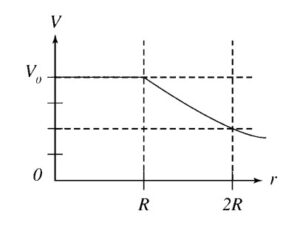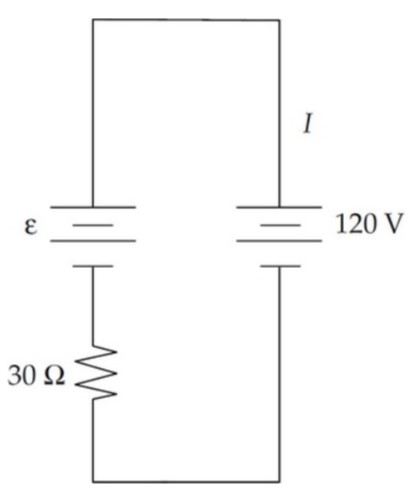Question

When the switch S is closed in the circuit shown above the reading on the ammeter is 3 A. When the switch is opened the current through the 10 Ω resistor will
(A) double
(B) increase but not double
(C) remain the same
(D) decrease but not be halved
(E) be halved
▶️Answer/Explanation
Ans: B
When the switch S is opened, the equivalent resistance, Req, of the parallel circuit increases. This results in the increase of the Req of the entire circuit. When the Req of the entire circuit increases, the total current, I, must decrease. This is because the total potential difference, V, is constant. The decrease in total I results in a decrease in the V across the 54 Ω, resistor. Since the total V has not changed, while the V across the 54 Ω has decreased, the V across the 10 Ω resistor must increase. This results in an increase in the current through the 10 Ω , resistor. The current is not doubled, though, because that would require the V across the 10 Ω, resistor to have doubled. This would only have occurred if the V across the 54 Ω, resistor had halved. That would have required the circuit’s current to have halved as well. This would have occurred only if the 10 Ω had a much greater resistance.
Question

A graph of electric potential Vas a function of the radius from the origin r is shown above. What can be concluded about the electric field in the region o < r < R?
(A) It increases linearly as r increases.
(B) It decreases linearly as r increases.
(C) It is zero.
(D) It increases non-linearly as r increases.
(E) It decreases non-linearly as r increases.
▶️Answer/Explanation
Ans:C
For the region o < r < R the electric potential is constant. For the potential to be constant, the electric field must be zero because \(E=-\frac{dV}{dr}\)
Question
A square conducting loop of wire lies so that the plane of the loop is perpendicular to a constant magnetic field of strength B. Suppose the length of each side of the loop f could be increased with time t so that l = kt2, where k is a positive constant. What is the magnitude of the emf induced in the loop as a function of time?
(A) 4Bk2 t3
(B) 2Bk2 t
(C) 4Bkt3
(D) 2Bkt
(E) \(\frac{Bk^{2}t^{5}}{5}\)
▶️Answer/Explanation
Ans: A
The area of the square is given by A= l2 = k2t4. Use Faraday’s law to determine the induced emf as shown below. Since the question asks for the magnitude of the emf, it is not necessary to include the negative sign in your answer.
\(\varepsilon =-\frac{d\Phi }{dt}=-\frac{d(BA)}{dt}=-B\frac{dA}{dt}\)
\(\varepsilon ==B\frac{d}{dt}(k^{2}t^{4})\)
\(\varepsilon =|-4Bk^{2}t^{3}|\)
Question

A battery with emf ε and internal resistance of 30 Ω is being recharged by connecting it to an outlet with a potential difference of 120 Vas shown above. While it is being recharged, 3 A flows through the battery. Determine the emf of the battery.
(A) 210V
(B) 150 V
(C) 90V
(D) 30V
(E) 9V
▶️Answer/Explanation
Ans: D
The potential difference around the loop must be zero according to Kirchhoff sloop rule. The current in the circuit is going counterclockwise if the battery is being charged by the 120 V outlet. A counterclockwise loop starting right below the 120 V outlet will produce the following, 120 – ε – (3)(30) = o. Therefore, ε = 30 V.
